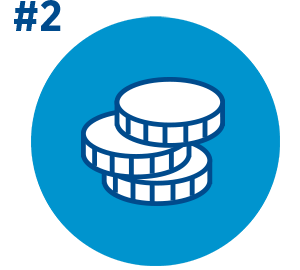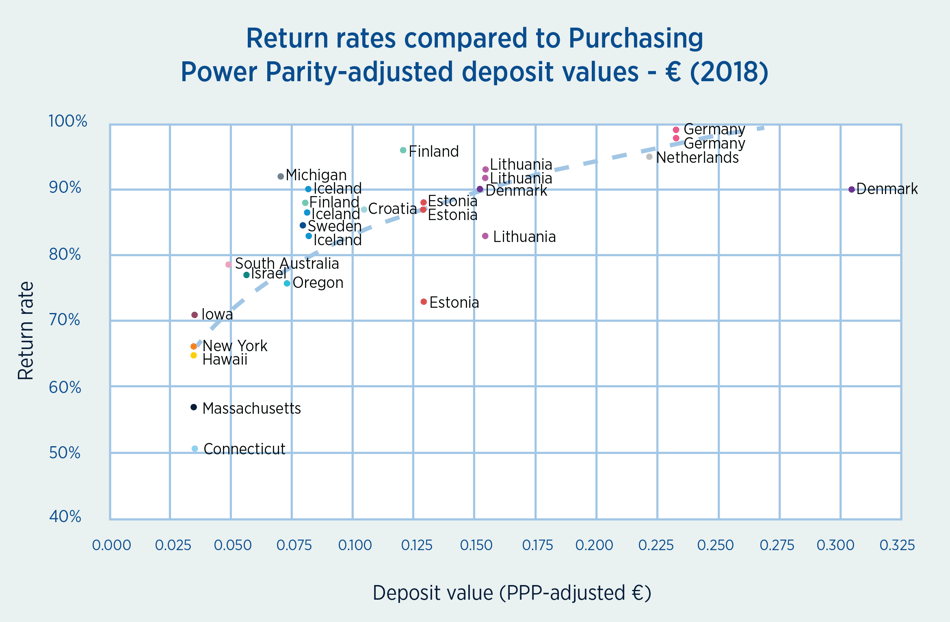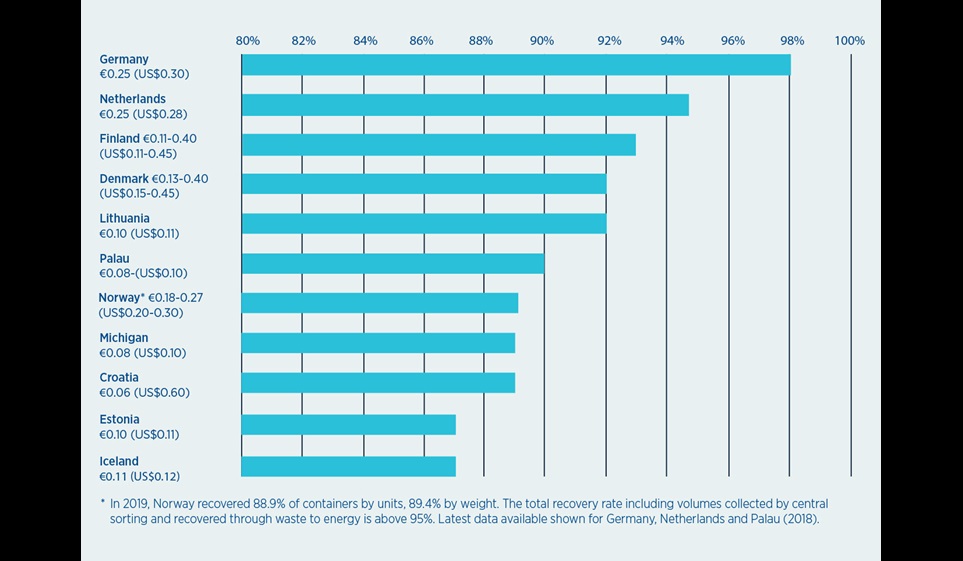Key elements of high-performing deposit return systems:
#2 - Minimum deposit value
In this System Spotlight article series, TOMRA provides adeep dive into the best practices of high-performing container deposit returnschemes.

Ocean plastic pollution, waste management costs and mandated collection targets are causing more and more governments to make sustainable resource management a priority. One policy that is actively being discussed is the concept of giving waste a value, to incentivize the public to collect it for recycling. This is a particularly popular approach for the items that are most commonly littered and found in oceans, such as beverage containers. Container deposit return systems (or “bottle bills”) add a deposit on the container on top of the price for the beverage, which is repaid when the consumer returns it to be recycled. A number of states or countries have committed to update existing deposit systems or develop new systems. In this ongoing article series and its white paper, "Rewarding Recycling: Learnings From the World's Highest-Performing Deposit Return Systems", TOMRA explores the best practices that separate the leaders in deposit return systems from the laggards.
Key element #2: Minimum deposit value
A financial incentive, to motivate consumers to treat packaging as a resource rather than trash, is what separates deposit return systems from other collection programs. Decades of redemption data show that meaningful deposit levels effectively drive more containers into the recycling stream, which in turn helps prevent beverage containers from ending up in the waste stream or as litter in the oceans and the environment.
Why is the deposit value important for a high-performing deposit return system (DRS)? To collect the vast majority of containers eligible for a deposit, the deposit value itself plays a critical role. As highlighted in the below graph, the redemption rate data generally show that the higher the deposit value, the higher the collection rate. This can be seen, in particular, across Germany, Lithuania and the Netherlands.

The data displayed here have been adjusted by Eunomia Research & Consulting to the purchasing power in each region to provide a relative comparison of the value of each deposit level. The data suggest it is difficult to reach a return rate of 80% or higher with a deposit value that is at or below €0.05 (adjusted for Purchasing Power Parity). This may be due to the relatively low financial incentive to participate. The return rate in Connecticut is a key example of this, where the US$0.05 (€0.04) deposit value yields a return rate of only 50%, making it tied for the lowest return rate in the world.
When determining deposit values, high-performing systems consider the purchasing power of the local market and its consumers, taking into account the relative economic strength and differences in wealth. Utilizing the available data on global return rates, setting the deposit value high enough to motivate consumers to return 90% or more of their empty containers, while low enough to discourage fraud, appears to be the most effective approach.
Performance metrics indicate a deposit of a minimum €0.10 (PPP-adjusted) or $US0.10 to be effective. However, the optimal deposit amount will most likely depend on the system’s collection infrastructure and the government’s collection ambitions.

2
Opting for a variable or flat DRS deposit value
There has been debate in some markets about whether to pursue a single or “flat” deposit value, in contrast to a variable deposit value. A variable deposit value means more than one deposit value, depending on the size of beverage container, material type or even beverage type. A flat deposit value is easiest for consumers and other parties to understand, creating a harmonized approach and providing clarity in the system. In order to ensure the incentive to redeem remains meaningful, policymakers may choose to set higher deposit values on containers that are larger and more expensive. Ultimately, the goal is to capture and recycle the highest number of containers.
Policymakers can also set a minimum deposit value(s) while giving beverage producers the option to utilize a higher deposit value. Effective deposit return systems allow producers to manage the day-to-day operations of the system, including the deposit value. Producers, with approval from policymakers, might decide to set a higher deposit value to further incentivize container returns, in order to reach their own performance targets, or to avoid penalties for under-performance.
Although a meaningful deposit value is integral to a high-performing deposit return system, high return rates also depend on a convenient network of redemption points to ensure the deposit does not act as a tax. See the “Convenient Redemption System for Consumers” chapter in our Rewarding Recycling white paper for more (pages 28-35).
System spotlight
Germany
When looked at on a global scale, there is a clear correlation between the deposit value and return rates of a DRS. Take Germany as an example of a leading, high-performing DRS. Germany has deposit systems for both refillable and non-refillable (one-way) containers, and initially required beverage producers and retailers to sell at least 72% of their beverages in refillable containers (known as a “reuse quota”).
However, the reuse quota was not met, so a DRS for one-way containers was implemented. To ensure one-way containers do not overtake refillables, policymakers set a high deposit value, but allowed producers to set a higher value if desired.3
As the country currently has the world’s highest return rate of deposit beverage containers, 98%, producers have not seen a need to raise the deposit value from its current level of €0.25 (US$0.30). Empowering producers in this way allows for flexibility in managing the program to achieve its objectives.
Connecticut, USA
The state of Connecticut, on the other hand, has one of the lowest deposit values and the world’s lowest return rate. The state’s US$0.05 (€0.04) deposit value has not been updated since its legislation was passed in 1978.4 This has resulted in a return rate of 50%.
In a survey of Connecticut residents, 27% reported that the deposit is too low to justify redeeming. This compares to just 3% in Michigan, where the deposit is a more meaningful US$0.10.5
If Connecticut’s deposit value had kept pace with inflation, the value would have reached US$0.19 (€0.17) today.6 With the deposit value being set by the legislature in statute and requiring the legislature to amend it, there is no mechanism in place to future-proof this key element as performance declines.
In recognition of these challenges, Connecticut recently passed legislation to overhaul the program, making a number of modernization measures. These included bringing the deposit value in line with the country’s highest-performing deposit programs and raising the deposit value from five to 10 cents.

Towards higher return rates
As the world looks to increase recycling and re-use in order to tackle waste, the evidence shows that financial incentives such as deposit return have an important role to play. However, for countries looking to implement best practice and achieve high return rates, there are important lessons to learn from existing schemes. Taking a holistic approach – which considers the optimal deposit value(s) in light of local purchasing power and the convenience of the redemption infrastructure – is key to creating an effective scheme.
1 Calculated based on figures compiled in “A DRS for Turkey: Final Report for Reloop & ISBAK,” Eunomia. 2019. To avoid a distorted representation of deposit value performance, the figure only presents redemption rates that are attributed to containers of a specific deposit value. Regions with multiple deposit values but only one reported redemption rate have not been included. South Australia: “Environmental info,” South Australia EPA. Accessed on January 20, 2021. Northern Territory removed due to unreliable data.
2 “Global Deposit Book 2020,” Reloop. 2020.
3 “Deposit return scheme in Germany: the world’s highest-performing drink container recycling system,” TOMRA. 2023.
4 “Connecticut,” BottleBill.org.
5 The Pert Group (2013) “Understanding Redemption Behaviors”. July 2013. Based on survey of redeemers and non-redeemers in USA.
6 Bureau of Labor Statistics Inflation Calculator.

